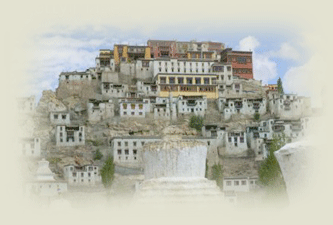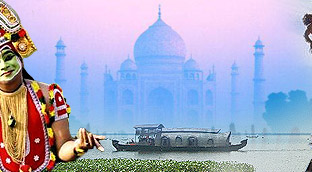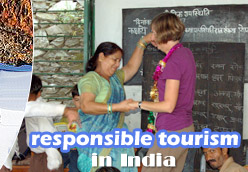Best of LADAKH
Duration: 5 NIGHTS/ 6 DAYS
Highlights: Leh City with Thiksey, Hemis, Shey, Pathar Sahib, Magnetic Hill ,Hall of Fame, Khardungla & Pangong Lake
Day 01: Delhi to Leh (1.5 Hrs Flight)
Arrival at Leh, Meet & greet and transfer to the Hotel. relax for the rest of the day to acclimatize to the rarefied air of high Himalayan Plateau.Lunch & Dinner at hotel, Overnight at the hotel.
 |
Day 02: Leh (Full day monasteries tour)
After breakfast full day excursion to Thiksey Monastery (16 Kms), Hemis Monastery (45 Kms) which is one of the biggest in this region. While returning to Leh visit Shey Palace (12 Kms). Packed lunch will be provided. In the evening return to the hotel for dinner & overnight at the hotel.
Day 03: Gurdwara Pathar Sahib, Magnetic Hill, Hall of Fame
After breakfast full day excursion tour of the famous Gurudwara Patthar Sahib (25 Kms) on the confulence of Indus & Zanskar Rivers, the Magnetic Hill (30 kms on Leh-Kargil Road) where you will find your vehicle slide uphill even in neutral and thus defying the law of gravity & Hall of Fame (war museum). Packed lunch will be provided, In the evening return to the hotel for dinner & overnight at the hotel.
Day 04: KhardungLa & Leh City tour
After breakfast drive to Khardung la (45 Kms), the highest motorable road in the world at 5600 meters ASL. The views from the top of the pass are amazing. This road carries on to the Nubra Valley (optional). Return to the hotel for hot lunch. Post lunch enjoy a tour of Leh city visiting Sangkar, Shanti Stupa, Leh Palace. Packed lunch will be provided,Dinner and overnight at the hotel.
Day 05: Pangong Lake
Leave 0500 Hrs to Pangong Lake (140 Kms, 5 Hrs drive one way) through Changla pass 5486 Mtrs. Enjoy the beautiful panoramic view of the villages below the pass. After crossing the pass halt for picnic lunch at Tsoltak, the summer pastureland of the yaks. Arrive Durbuk and from there a short drive takes you to the western shore of the lake. Enjoy the landscape in the back drop of the Lake. This famous blue brackish Lake of Pangong is 5/6 Kms wide and over 144 Kms long with half of its running the other side of the "INDO CHINA BORDER". One rarely feels so close to nature and environment and the scenery is unforgettable. In the late afternoon drive back to Leh. Dinner & Overnight at Hotel.
Day 06: Leh to Delhi
After breakfast transfer to the airport for your flight to the home destination
For tour cost and other details please contact Sanjay/Sunil at
QUEST TO LADAKH TOUR
(DAY BY DAY DETAIL ITINERARY)
Duration: 06night/ 7 days
Day 01: Arrive Leh from Delhi.
Met by representative at the airport and transfer to hotel. Day complete rest to acclimatize. Evening at leisure. Overnight at the hotel.
Day 02: Leh
Sightseeing tour of Shey, Thiksey and Hemis monasteries with packed lunch. Dinner and overnight at the hotel.
SHEY PALACE AND GOMPA: Situated on a hillock 15 Kms upstream from Leh, it was once the residence of the royal family. According to tradition, it was the seat of power of the pre-Tibetan kinds. A 7.5 mts high copper statue of Buddha, plated with gold and the largest of its kind, is installed here.
THIKSEY GOMPA: 19 Kms from Leh, spectacularly sited, Thiksey is one of the largest and architecturally most impressive Gompas. There are several temples in this Gompas, containing images, stupas and wall paintings of Buddha, which are exquisite.
HEMIS GOMPA: 40 Kms from Leh, it is the wealthiest, best known and biggest Gompa of Ladakh. Its popularity stems from the major annual festival held here in summer. The festival is in honor of Guru Padma Sambhava’s birth anniversary. It also has the largest Thanka in Ladakh which is unfurled once in 12 years (nest in 2004) Hemis was built in 1630 during the reign of Singge Namgyal, an illustrious ruler of Ladakh. It flourished under the Namgyal Dynasty for the royalty favored the Drugpa sect, which is managed the monastery. It is divided into two, the assembly hall on the right and the main temple on the left. The hall (Dukhang) is also used as “green room” by the dancers during the festival. The temple is known as Tshogkhang. The verandahs have a surfeit of frescoes, among them the Buddhist “Wheel Of Life” (Kalachakra) and the lords of the four quarters, besides the prayer wheel.
Day 03:
Sightseeing tour of Ladakh Hall of fame, Sankar and Leh palace in the morning. Lunch at the hotel. Evening visit Spituk, Magnetic hill, confluence of Indus and Zanskar river and the Shanti Stupa at sunset. Dinner and overnight at the hotel.
LADAKH HALL OF FAME: (Kargil War Meseum) The Hall of Fame is a glorious museum constructed by the Indian Army. It is worth a visit for every citizen. You can see the memorabilia, eminent defense personalities with biographies, images and weapons used during the Kargil and other key strategic battles fought in Ladakh. And belongings of the enemy soldiers found at war site. All the martyr and the gallantry awards…
“Here’s something that you will be proud of our defense personnel who sacrificed themselves so that we could live in peace.”
leh palace (Namgyal Tsemo):King Gragspa Bum-Lde built the “Red Gonpa” known as Tsemo Gonpa in 1430 AD. The monument has three-storied Maitriya Buddha's statue and a one-storied statue of Avaloketesvara and Manjushri. The Tsemo Sungbum Chenmo (sacred text) was written in gold and silver, Tisuru Stupa consist of 108 temples, which were remarkable works done in the reign of king Graspa-Bum-Lde.
The Namgyal Tsemo (victory Peak) was build by King Tashi Namgyal after the reunification of upper and lower Ladakh and victory over Hor and their bodies are placed under an image of Mahakala, the guardian deities to stop further invasion of Hor. The Leh palace known as 'Lechen Palkhar' was built by Singay Namgyal around in the beginning of 17th Century A.D. The nine-storied palace is now deserted, and the ASI (Archeological Survey Of India) has taken up the renovation work.
SPITUK GOMPA: 8 Kms from Leh, it stands prominently on the top of hillock commanding a panoramic view of the Indus Valley for miles. Many icons of Buddha and fine Thankas are to be found in this 15th century Gompa. The Gompa also houses a collection of ancient masks, antique arms, and an awe-inspiring image of Mahakaal. The face of the Kali image is kept covered and is revealed only at the annual function at January every year.
MAGNETIC HILL: Defying the Law of gravity. This place is close to the Gurdwara Shri Patthar Sahib. It has been noticed that when a vehicle is parked on neutral gear on this metallic road the vehicle slides up-hill that’s the Believe it or not of Ladakh!
CONFLENCE OF THE ZANSKAR & INDUS: On way to Sham Valley before Nimu village one can have this magnificent view of two rivers in wed-lock! In seasons they have different colors and flow and wildness.
SHANTI STUPA (Japanese Peace Pagoda) : Shanti Stupa/Japanese peace pagoda is build by a
Japanese religious organization headed by Head monk Nakamura with the help from the organization and local people. It is situated at a hill top in Cahngspa village providing a bird eye view of the Leh town and the surrounding mountain peaks. Architecturally it has the Japanese touch with small clean rooms on the side for meditators and the main Japanese shrine at the entrance.
Day 04:
Excursion to Khardungla pass. World’s highest motorable road. Evening at leisure. Dinner and overnight at the hotel.
khardungla pass: The road journey to Nubra valley leads through Khardung La pass (The highest Motorable road in the world) 18,390 ft. around 39 Kms. Away from Leh. There are two checkpoints on the both sides of the pass. Khardong is the first village of Nubra valley at higher altitude than Deskit and other villages.
Day 05:
Morning drive from Leh to Tsomoriri Lake. Overnight at the Tsomoriri camp.
TSOMORIRI LAKE: The area traversed by the Manali Leh road, and containing the drainage basins of Tsomoriri and other lakes is known as Rupshu. Here, the Zanskar range is transformed into bare rolling many-hued hills divided by open high altitude valleys scoured by dust-devils. It is a landscape quite unlike any other in Ladakh- or elsewhere in India.
The first circuit follows the Manali road over the Taglang-la as far as Debring, a Chang-pa camping place. From here it strikes off east on a rough track across the basin of the twin lakes Startsapuk-Tso (Fresh water) and the Tso-kar (Salt Water), over the Polokangka-la (About 16,500 feet / 5030 M) to Sumdo in the Puga Valley-near the site of old sulphur mines, then over a roller-coaster track to the head of the Tso-moriri and on to Korzok, a quarter of the way along the lake’s 20-km length.
The alternative route, instead of leaving the Indus at Upshi, carries on up the river, as it snakes its way through a gorge between the Ladakh and Zanskar ranges, to the village of Chumathang, where there is a hot spring. At Mahe, some 17 km further, the road crosses from the north to the south bank of the river by a bridge; it then follows the Puga steam up to join the first circuit at Sumdo.
Day 06:
Explore the lake area and visit to Korzok monastery. Drive back to Leh. Later in the evening explore the Leh market on foot to buy souvenirs etc. On the way visit the Jokhang temple and the Mosque. Dinner and overnight at the hotel at Leh.
Korzok, is situated at 15000 ft. (4572 M) with its dozen or so houses and its Gompa appearing like a mirage among the barren hills, is the only permanent settlement in Rupshu valley; otherwise the region is inhabited only by nomadic Chang-pa herds people. The Rupshu Cang-pa lives in tents all the year round, moving in accordance with an old-established annual routine between the pastures that exist wherever an occasional stream carrying snowmelt from the heights makes possible the reportedly highly nutritious. The few barley fields at Korzok must be among the highest cultivation in the world, but there is no guarantee that the crop will ripen every year.
Even Rupshu’s bare hills support a sparse population of wildlife, and the animal most likely to be spotted is the Kyang, the wild ass of the Ladakh and Tibet plateaux. More plentiful are marmots (ubiquitous on mountain slopes all over Ladakh), hares, and an unusual tail-less rat. The lakes are breeding-grounds for numerous species of birds. Chief among them are the bar-headed goose, found in great number on the Tso-moriri, the great crested grebe, the Brahmini duck (ruddy sheldrake) and the brown-headed gull.
LEH MOSQUE: The Jama Masjid of Leh was built in 1666-67 AD under an agreement between Mughal Emperor Aurangzeb and Ladakhi ruler Deldan Namgyal. Initialy, the architecture of the mosque bore Tibetan, Central Asian and Ladakhi style. In recent years it has been reconstructed and given a new look with minarets and domes.
Jokhang: the Ladakh Buddhist Association in 1957 built the small Gonpa opposite to SBI and known as Jokhang in the main bazaar, which is open throughout the day for visitors. The Gonpa contains statue of Joyo Rinpoche (crowned Buddha).
SOUVENIRS & SHOPPING IN LEH: In Leh you can buy Pashmina Shawl, Handicraft Items such as Tibetan or Kahsmiri carpets, wall paintings, wooden masks, Ladakhi wooden table carved and painted, wooden dragons for wall hangings etc. You may also want to buy Tibetan and Ladakhi artifacts from the Tibetan market or antique shops. One can buy local apricot Jam or dry apricots. You can bargain in shopping up to 20% depending on the item and the shop. It is not advisable to buy electronic items as they are more cheaper in Delhi. Do not buy any old Thanka paintings or Statue as they might be fake and are not allowed to take out of Ladakh.
Day 07:
Early morning after breakfast, departure transfer to Leh airport. Fly Leh-Delhi.
TOUR ENDS.
For tour cost and other details please contact Sanjay/Sunil at













